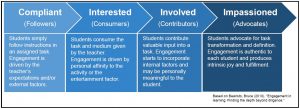Muffoletto (1994) emphasizes that “technology is not a collection of machines and devices, but a way of acting.” Currently, there is no shortage of technology enhanced learning experiences (TELEs) that help to engage students in different ways of acting. As Trotter (1998) argues, the presence of technology does not automatically create better educational outcomes, it depends on how we engage students with technology. There are a number of frameworks for technology integration and learning objectives, but not many on student engagement. Teachers often identify student excitement with effective engagement, unfortunately that assumption can be misguided. Perhaps a better way forward is to attempt to create a framework for engagement. Below is a visualization of a framework adapted from Beairsto (2010) that attempts to identify engagement as a continuum:

In relation to technology, an “interested” level of engagement is characteristic of many game-based technologies that simply turn learning into a consumption event. At a higher “impassioned” level of engagement, student learning is transformative, self-driven and self-sustaining; this level is characteristic of many cases were students turn class projects into successful companies.
This may sound crazy, but if I were to design a technology enhanced learning experience, I would aim to challenge the student(s) with a real world problem of personal importance. The “way of acting” would employ any technology tool that helps the student solve the problem, and include a goal for the solution to be widely used beyond the school environment.
Beairsto, B. (2010). Engagement in learning: Finding the depth beyond diligence. Retrieved from https://tc2.ca/uploads/PDFs/Critical%20Discussions/engagement_in_learning.pdf.
Muffoletto, R. (1994). Technology and restructuring education: Constructing a context. Educational Technology, 34(2), 24-28.
Trotter, A. (Ed.) (1998). Technology counts 1998: Putting school technology to the test (special report). Education Week, 18(5).